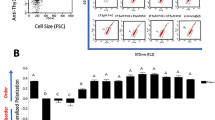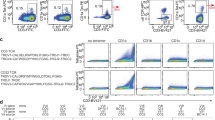Abstract
The plasma membranes of eukaryotic cells are not uniform and possess distinct cholesterol– and sphingolipid–rich raft microdomains that are enriched in proteins known to be essential for cellular function. Lipid raft microdomains are important for T cell receptor (TCR)–mediated activation of T cells. However, the importance of lipid rafts on antigen presenting cells (APCs) and their role in major histocompatibility (MHC) class II–restricted antigen presentation has not been examined. MHC class II molecules were found to be constitutively present in plasma membrane lipid rafts in B cells. Disruption of these microdomains dramatically inhibited antigen presentation at limiting concentrations of antigen. The inhibitory effect of raft disruption on antigen presentation could be overcome by loading the APCs with exceptionally high doses of antigen, showing that raft association concentrates MHC class II molecules into microdomains that allow efficient antigen presentation at low ligand densities.
This is a preview of subscription content, access via your institution
Access options
Subscribe to this journal
Receive 12 print issues and online access
$209.00 per year
only $17.42 per issue
Buy this article
- Purchase on Springer Link
- Instant access to full article PDF
Prices may be subject to local taxes which are calculated during checkout









Similar content being viewed by others
References
Simons, K. & Ikonen, E. Functional rafts in cell membranes . Nature 387, 569–572 (1997).
Harder, T. & Simons, K. Caveolae, DIGs, and the dynamics of sphingolipid-cholesterol microdomains. Curr. Opin. Cell Biol. 9, 534–542 ( 1997).
Brown, D.A. & London, E. Functions of lipid rafts in biological membranes. Annu. Rev. Cell Dev. Biol. 14, 111–136 (1998).
Varma, R. & Mayor, S. GPI-anchored proteins are organized in submicron domains at the cell surface. Nature 394 , 798–801 (1998).
Pralle, A., Keller, P., Florin, E., Simons, K. & Horber, J.K. Sphingolipid-cholesterol rafts diffuse as small entities in the plasma membrane of mammalian cells. J. Cell Biol. 148, 997–1008 (2000).
Keller, P. & Simons, K. Cholesterol is required for surface transport of influenza virus hemagglutinin. J. Cell Biol. 140, 1357–1367 (1998).
Horejsi, V. et al. GPI-microdomains: a role in signalling via immunoreceptors . Immunol. Today 20, 356– 361 (1999).
Rodgers, W. & Rose, J.K. Exclusion of CD45 inhibits activity of p56lck associated with glycolipid-enriched membrane domains. J. Cell Biol. 135, 1515–1523 (1996).
Kabouridis, P.S., Magee, A.I. & Ley, S.C. S-acylation of LCK protein tyrosine kinase is essential for its signalling function in T lymphocytes. EMBO J. 16, 4983–4998 (1997).
Zhang, W., Trible, R.P. & Samelson, L.E. LAT palmitoylation: its essential role in membrane microdomain targeting and tyrosine phosphorylation during T cell activation . Immunity 9, 239–246 (1998).
Xavier, R., Brennan, T., Li, Q., McCormack, C. & Seed, B. Membrane compartmentation is required for efficient T cell activation. Immunity 8, 723– 732 (1998).
Moran, M. & Miceli, M.C. Engagement of GPI-linked CD48 contributes to TCR signals and cytoskeletal reorganization: a role for lipid rafts in T cell activation. Immunity 9, 787– 796 (1998).
Montixi, C. et al. Engagement of T cell receptor triggers its recruitment to low-density detergent-insoluble membrane domains. EMBO J. 17, 5334–5348 (1998).
Janes, P.W., Ley, S.C. & Magee, A.I. Aggregation of lipid rafts accompanies signaling via the T cell antigen receptor. J. Cell Biol. 147, 447–461 (1999).
Viola, A., Schroeder, S., Sakakibara, Y. & Lanzavecchia, A. T lymphocyte costimulation mediated by reorganization of membrane microdomains . Science 283, 680–682 (1999).
Rothberg, K.G. et al. Caveolin, a protein component of caveolae membrane coats. Cell 68, 673–682 ( 1992).
Kilsdonk, E.P. et al. Cellular cholesterol efflux mediated by cyclodextrins. J. Biol. Chem. 270, 17250–17256 (1995).
Scheiffele, P., Roth, M.G. & Simons, K. Interaction of influenza virus haemagglutinin with sphingolipid- cholesterol membrane domains via its transmembrane domain. EMBO J. 16, 5501–5508 ( 1997).
Jenkins, M.K., Pardoll, D.M., Mizuguchi, J., Quill, H. & Schwartz, R.H. T-cell unresponsiveness in vivo and in vitro: fine specificity of induction and molecular characterization of the unresponsive state. Immunol. Rev. 95, 113–135 (1987).
Barisas, B.G., Wade, W.F., Jovin, T.M., Arndt-Jovin, D. & Roess, D.A. Dynamics of molecules involved in antigen presentation: effects of fixation. Mol. Immunol. 36, 701 –708 (1999).
Germain, R.N. & Hendrix, L.R. MHC class II structure, occupancy and surface expression determined by post-endoplasmic reticulum antigen binding . Nature 353, 134–139 (1991).
Davidson, H.W., Reid, P.A., Lanzavecchia, A. & Watts, C. Processed antigen binds to newly synthesized MHC class II molecules in antigen-specific B lymphocytes. Cell 67, 105– 116 (1991).
Brown, D.A. & Rose, J.K. Sorting of GPI-anchored proteins to glycolipid-enriched membrane subdomains during transport to the apical cell surface. Cell 68, 533– 544 (1992).
Cheng, P.C., Dykstra, M.L., Mitchell, R.N. & Pierce, S.K. A role for lipid rafts in B cell antigen receptor signaling and antigen targeting . J. Exp. Med. 190, 1549– 1560 (1999).
Glickman, J.N., Morton, P.A., Slot, J.W., Kornfeld, S. & Geuze, H.J. The biogenesis of the MHC class II compartment in human I-cell disease B lymphoblasts. J. Cell Biol. 132, 769–785 (1996).
Watts, T.H., Brian, A.A., Kappler, J.W., Marrack, P. & McConnell, H.M. Antigen presentation by supported planar membranes containing affinity- purified I-Ad. Proc. Natl Acad. Sci. USA 81, 7564– 7568 (1984).
Watts, T.H. T cell activation by preformed, long-lived Ia-peptide complexes. Quantitative aspects. J. Immunol. 141, 3708– 3714 (1988).
Grakoui, A. et al. The immunological synapse: a molecular machine controlling T cell activation. Science 285, 221– 227 (1999).
Field, K.A., Holowka, D. & Baird, B. Compartmentalized activation of the high affinity immunoglobulin E receptor within membrane domains. J. Biol. Chem. 272, 4276–4280 (1997).
Jenei, A. et al. HLA class I and II antigens are partially co-clustered in the plasma membrane of human lymphoblastoid cells. Proc. Natl Acad. Sci. USA 94, 7269–7274 ( 1997).
Turley, S.J. et al. Transport of peptide-MHC class II complexes in developing dendritic cells. Science 288, 522– 527 (2000).
Huby, R.D., Dearman, R.J. & Kimber, I. Intracellular phosphotyrosine induction by major histocompatibility complex class II requires co-aggregation with membrane rafts. J. Biol. Chem. 274, 22591–22596 (1999).
Smart, E.J., Ying, Y.S., Mineo, C. & Anderson, R.G. A detergent-free method for purifying caveolae membrane from tissue culture cells. Proc. Natl Acad. Sci. USA 92, 10104– 10108 (1995).
Song, K.S. et al. Co-purification and direct interaction of Ras with caveolin, an integral membrane protein of caveolae microdomains. Detergent-free purification of caveolae microdomains. J. Biol. Chem. 271, 9690–9697 (1996).
Monks, C.R., Freiberg, B.A., Kupfer, H., Sciaky, N. & Kupfer, A. Three-dimensional segregation of supramolecular activation clusters in T cells. Nature 395, 82–86 (1998).
Dustin, M.L. et al. A novel adaptor protein orchestrates receptor patterning and cytoskeletal polarity in T-cell contacts. Cell 94, 667–677 (1998).
Wang, W. et al. A naturally processed peptide presented by HLA-A*0201 is expressed at low abundance and recognized by an alloreactive CD8+ cytotoxic T cell with apparent high affinity. J. Immunol. 158, 5797–5804 ( 1997).
Demotz, S., Grey, H.M. & Sette, A. The minimal number of class II MHC-antigen complexes needed for T cell activation. Science 249, 1028 –1030 (1990).
Harding, C.V. & Unanue, E.R. Quantitation of antigen-presenting cell MHC class II/peptide complexes necessary for T-cell stimulation. Nature 346, 574–576 ( 1990).
Ronchese, F., Schwartz, R.H. & Germain, R.N. Functionally distinct subsites on a class II major histocompatibility complex molecule. Nature 329, 254–256 (1987).
Anderson, H.A. & Roche, P.A. Phosphorylation regulates the delivery of MHC class II invariant chain complexes to antigen processing compartments. J. Immunol. 160, 4850–4858 (1998).
Acknowledgements
We thank D. Winkler for peptide synthesis, J. Ashwell for the cytochrome c-specific 2B4 T cell hybridoma, J. Miller for the class II antiserum, T. Brotz for advice and assistance with our microscopy studies and A. Singer and R. Hodes for discussions and for reading the manuscript.
Author information
Authors and Affiliations
Corresponding author
Rights and permissions
About this article
Cite this article
Anderson, H., Hiltbold, E. & Roche, P. Concentration of MHC class II molecules in lipid rafts facilitates antigen presentation. Nat Immunol 1, 156–162 (2000). https://doi.org/10.1038/77842
Received:
Accepted:
Issue Date:
DOI: https://doi.org/10.1038/77842
This article is cited by
-
Cancer cell metabolism and antitumour immunity
Nature Reviews Immunology (2024)
-
Cholesterol accumulation on dendritic cells reverses chronic hepatitis B virus infection-induced dysfunction
Cellular & Molecular Immunology (2022)
-
Cis-interaction of ligands on a supported lipid bilayer affects their binding to cell adhesion receptors
Science China Physics, Mechanics & Astronomy (2021)
-
Myeloid apolipoprotein E controls dendritic cell antigen presentation and T cell activation
Nature Communications (2018)
-
The Interplay of Lipids, Lipoproteins, and Immunity in Atherosclerosis
Current Atherosclerosis Reports (2018)



